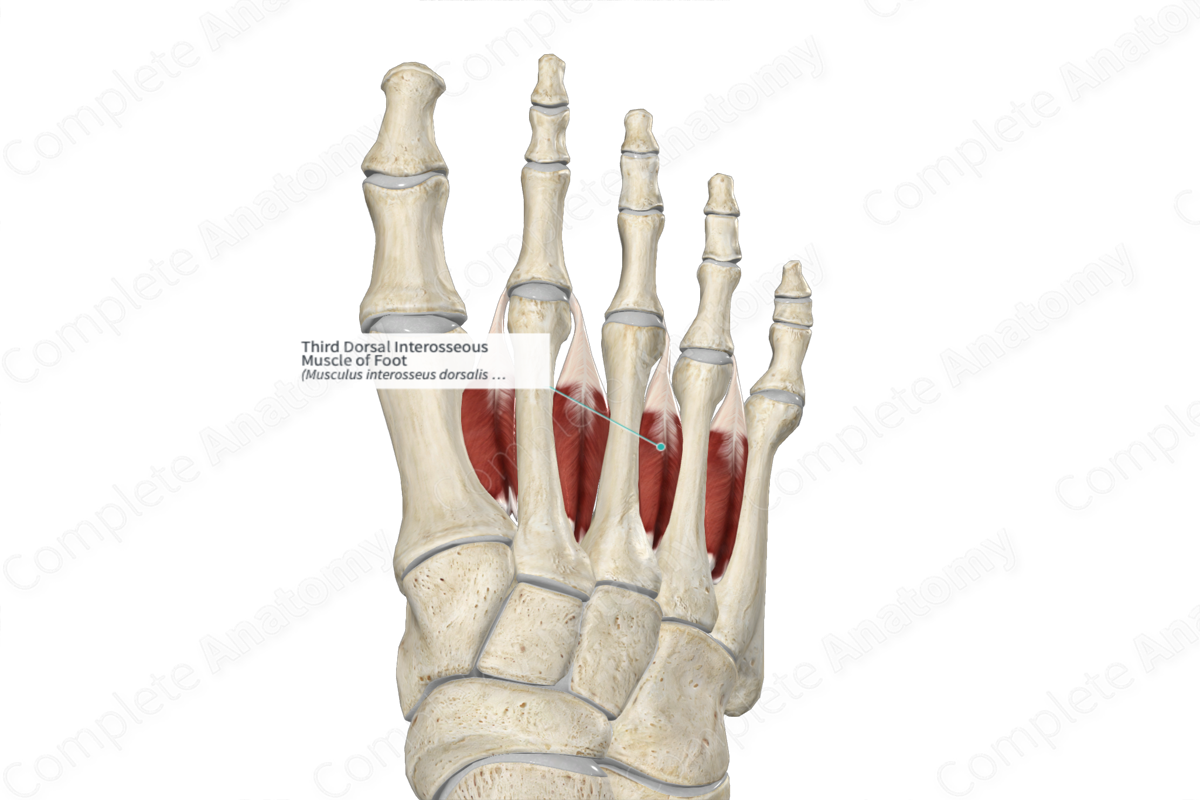
Third Dorsal Interosseous Muscle of Foot
Musculus interosseus dorsalis pedis tertius
Read moreQuick Facts
Origin: Lateral aspect of body of third metatarsal bone and medial aspect of body of fourth metatarsal bone.
Insertion: Lateral aspect of base of proximal phalanx of third toe and extensor expansion of third toe.
Action: Abducts third toe at its metatarsophalangeal joint; simultaneously flexes metatarsophalangeal joint and extends interphalangeal joints of third toe.
Innervation: Deep branch of lateral plantar nerve (S2-S3).
Arterial Supply: Arcuate, dorsal and plantar metatarsal, and dorsal digital arteries of foot.
Origin
The third dorsal interosseous muscle of foot consists of two heads:
- the medial head, which originates from the lateral aspect of the body of third metatarsal bone;
- the lateral head, which originates from the medial aspect of the body of fourth metatarsal bone.
Insertion
The fibers of the third dorsal interosseous muscle of foot travel anteriorly to the third toe and insert, via a short tendon, onto the:
- lateral aspect of the base of the proximal phalanx of third toe;
- extensor expansion of third toe.
Key Features & Anatomical Relations
The third dorsal interosseous muscle of foot is located in the fourth layer of muscles that are found in the plantar part of the foot. It is a short, bipennate skeletal muscle.
It is located:
- superior to the adductor hallucis muscle, the third lumbrical muscle of foot, and the second plantar interosseous muscle of foot;
- medial to the fourth metatarsal bone;
- lateral to the third metatarsal bone.
One of the perforating branches of deep plantar arch travels in between the two heads of the third dorsal interosseous muscle of foot.
Actions
The third dorsal interosseous muscle of foot is involved in multiple actions:
- abducts the proximal phalanx of third toe (i.e., draws it away from the longitudinal axial line of the second toe) at the third metatarsophalangeal joint;
- simultaneously flexes the third metatarsophalangeal joint and extends the interphalangeal joints of the third toe, which occurs when the second lumbrical and first plantar interosseous muscles of foot contract simultaneously with it (Standring, 2016).
List of Clinical Correlates
- Clawing of the toes
- Charcot-Marie-Tooth disease
References
Standring, S. (2016) Gray's Anatomy: The Anatomical Basis of Clinical Practice. Gray's Anatomy Series 41st edn.: Elsevier Limited.
Actions
The third dorsal interosseous muscle of foot is involved in multiple actions:
- abducts the proximal phalanx of third toe (i.e., draws it away from the longitudinal axial line of the second toe) at the third metatarsophalangeal joint;
- simultaneously flexes the third metatarsophalangeal joint and extends the interphalangeal joints of the third toe, which occurs when the second lumbrical and first plantar interosseous muscles of foot contract simultaneously with it (Standring, 2016).
Learn more about this topic from other Elsevier products
Foot Muscle

The extrinsic foot muscles are those whose muscle bellies reside proximal to the foot, but tendons directly insert into the bones and ligaments.



